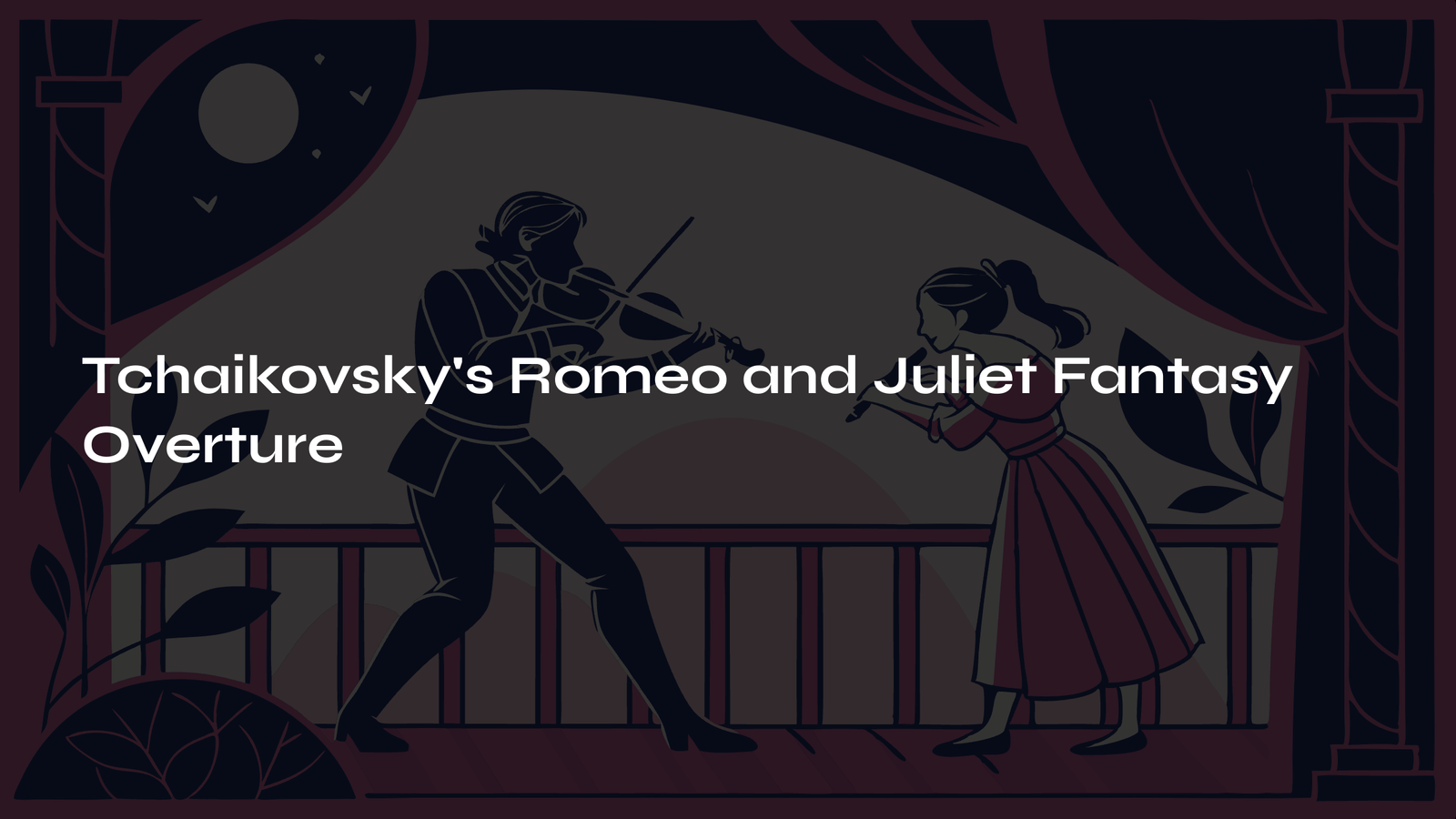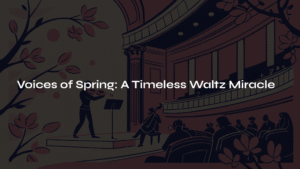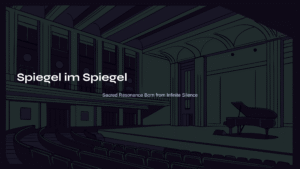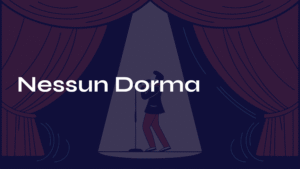Table of Contents
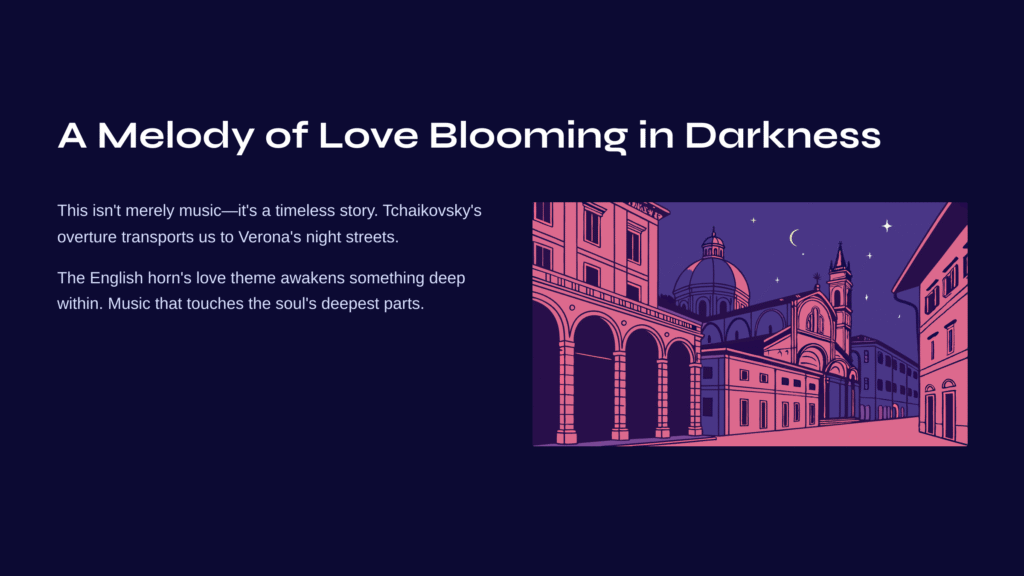
A Melody of Love Blooming in Darkness
From the moment the first notes flow forth, I knew. This isn’t merely music—it’s a story that transcends time. Every time I listen to Tchaikovsky’s Romeo and Juliet Fantasy Overture, the emotion I feel remains constant. It’s as if I’m standing on the night streets of Verona four centuries ago, witnessing those beautiful moments of collision between love and fate.
I still vividly remember the tremor I felt when first hearing this piece. When the English horn began quietly playing the love theme, something within my heart seemed to awaken. Have you ever experienced such a moment? When music transcends mere sound to touch the deepest parts of your soul?

1869: A Composer’s Challenge
Tchaikovsky began writing this work in 1869, at the age of 29. At the time, he was teaching harmony at the St. Petersburg Conservatory while seeking his path as a composer. Interestingly, this piece’s birth involved a suggestion from his friend and mentor, Mily Balakirev. Balakirev didn’t merely provide an idea—he offered specific advice on the work’s structure and themes.
Translating Shakespeare’s tragedy into music was no easy task. Tchaikovsky abandoned the original’s complex narrative, instead focusing on three core elements: the religious solemnity represented by Friar Lawrence, the fierce conflict between the Capulet and Montague families, and the pure love of Romeo and Juliet. These three themes interweave, clash, and ultimately create a complete story within the solid framework of sonata form.
The premiere took place in Moscow in 1870, but the reception was lukewarm. Tchaikovsky didn’t succumb to this setback and revised the work multiple times. Particularly in his final 1880 revision, he completely rewrote the ending to achieve the dramatic climax we hear today.
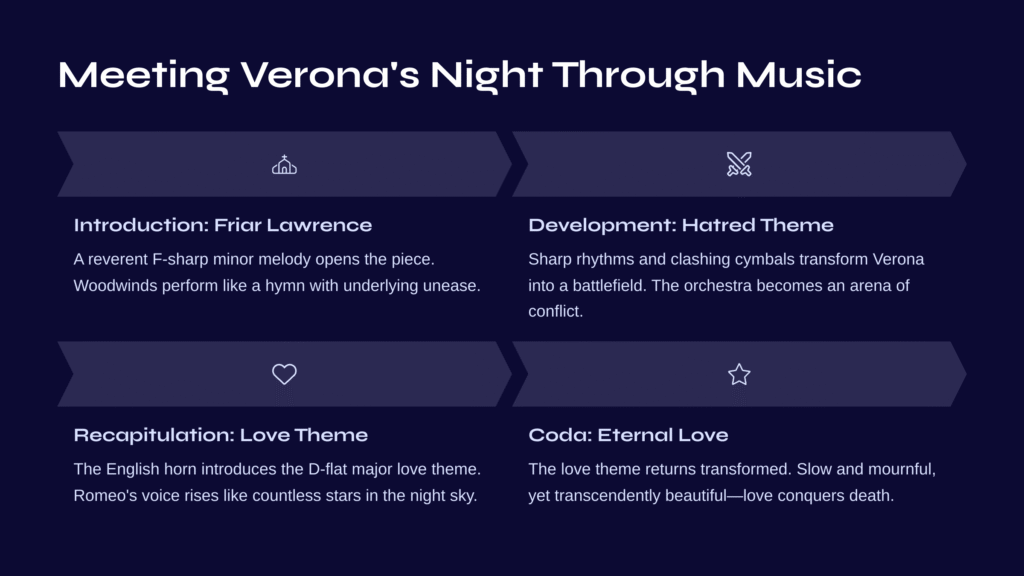
Meeting Verona’s Night Through Music
Introduction: Friar Lawrence’s Prophecy
The piece opens with a heavy, reverent melody in F-sharp minor. This is the chorale-like theme representing Friar Lawrence. The woodwinds perform this melody like a hymn, yet it harbors a strange unease—like the voice of a prophet foreseeing the tragedy to come.
Whenever I hear this section, I envision a priest standing alone beneath the high cathedral ceiling. In his hands lies a letter containing secret plans for the two lovers; in his heart dwells both an earnest desire to save their love and fear of what fate may bring.
Development: A Dance of Fiery Hatred
Suddenly the atmosphere shifts. Sharp rhythmic motifs from the strings, clashing cymbals, aggressive harmonies from the winds—all transform Verona’s streets into a battlefield. This is the “hatred theme” depicting the fateful conflict between the Capulets and Montagues.
The music cuts sharp as clashing blades, complex as entangled footsteps. Tchaikovsky transforms the entire orchestra into one massive arena. The violin’s agile movements suggest swift swordplay, the brass’s magnificent harmonies represent family pride, and the timpani’s regular pulse symbolizes the heartbeat of revenge.
Recapitulation: The Eternal Love Theme
When all this tumult subsides, a magical moment arrives. The English horn and muted violas quietly begin the love theme. As the warm melody in D-flat major flows forth, the world suddenly becomes another place entirely. This is Romeo’s voice.
I can never forget the shock I felt hearing this melody for the first time. It was like countless stars suddenly rising into the sky. The melody endlessly ascends and gracefully descends, containing every emotion of love within it—excitement, longing, happiness, and somehow, an inexplicable sadness.
Then the flute and oboe perform Juliet’s theme. Lighter and more pure than Romeo’s melody, yet it harbors a premonition of fate. The horn’s descending melody follows classical music’s traditional expression of sorrow or anxiety. Tchaikovsky had already planted the seeds of tragedy within this beautiful moment.
Coda: Ascension to Eternity
The piece’s final section is truly magnificent. After the hatred and love themes clash violently one last time, everything falls silent. Then the love theme returns, but in a completely transformed state. Slow and mournful like a funeral march, yet simultaneously possessing transcendent beauty.
Hearing this moment, I always wonder: Can death conquer love? Tchaikovsky’s answer seems clear. Though the body may perish, love is eternal—this is the message music conveys to us.
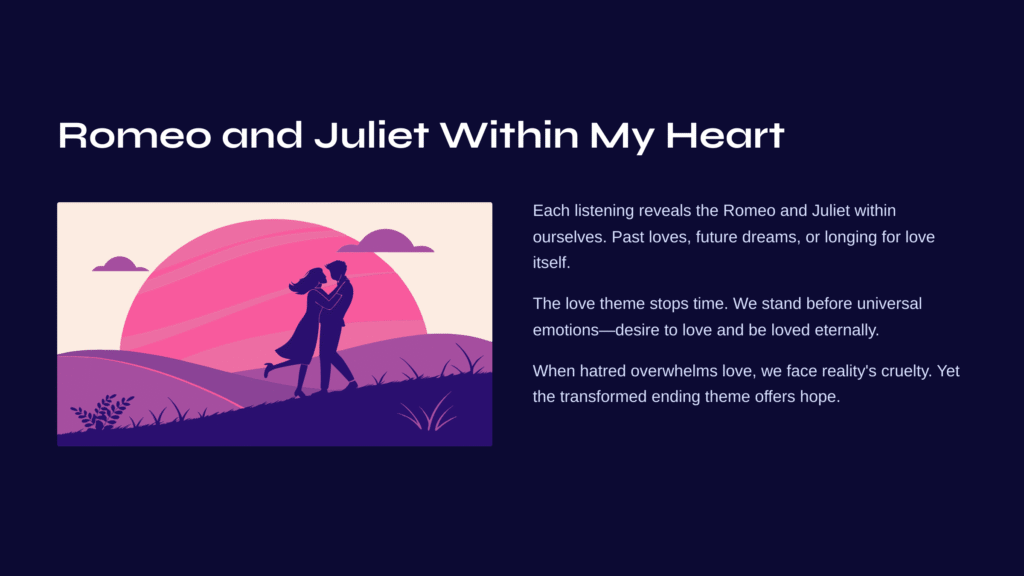
Romeo and Juliet Within My Heart
Every time I listen to this piece, I encounter the Romeo and Juliet within myself. It might be some past love, some future dream, or simply pure longing for love itself. Tchaikovsky’s music possesses the power to evoke such universal emotions.
Especially when the love theme flows forth, I feel as if time has stopped. In that moment, transcending age, gender, nationality, or era, I stand before those pure emotions everyone has experienced at least once—the desire to be loved, to love, and for that love to be eternal.
Yet this piece’s true power lies not only in its beauty but also in its unflinching view of reality. When the hatred theme overwhelms the love theme, we confront the world’s cruelty. We realize how fragile individual love can be before family grudges, social prejudice, and fate’s cruel games.
But when the love theme returns in its transformed state at the end, I see hope. Though the two lovers have died, their love is no longer threatened by hatred. Rather, through their tragic end, love has become something more pure and eternal.
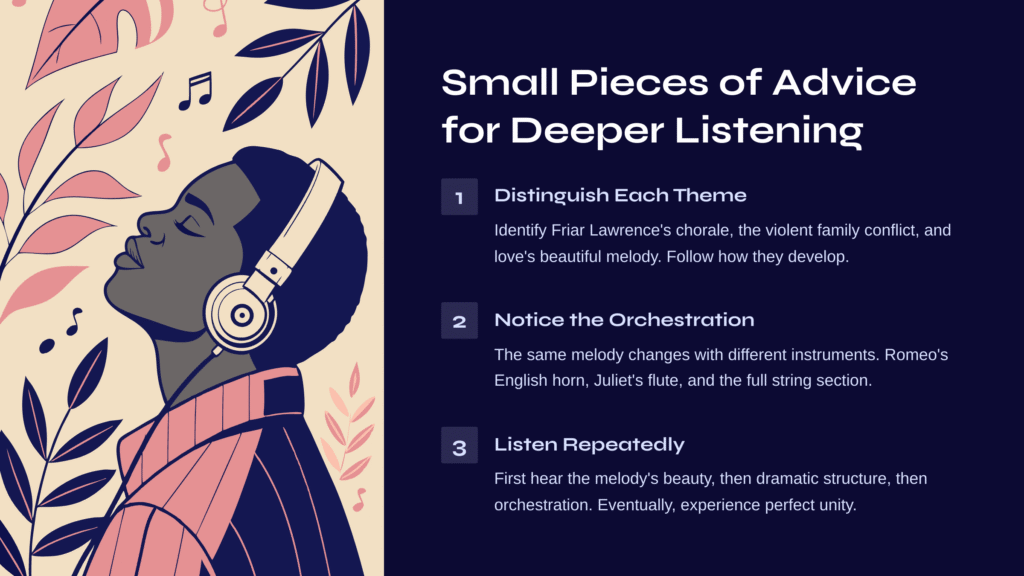
Small Pieces of Advice for Deeper Listening
If you’re hearing this piece for the first time, I recommend first distinguishing between each theme. Friar Lawrence’s solemn chorale, the violent rhythm of family conflict, and love’s beautiful melody. Following how these three elements appear, develop, and transform will reveal how precisely Tchaikovsky constructed his musical narrative.
Second, pay attention to the orchestration. The same melody can convey completely different feelings depending on which instrument performs it. Romeo’s theme played by English horn, Juliet’s theme by flute, and the love theme performed by the full string section at the end—each carries its own distinct emotional coloring.
Finally, this is a work that reveals new aspects with each repeated listening. The first time, you’ll be struck by the melody’s beauty; the second, by the dramatic structure; the third, by the intricate orchestration. Eventually, you’ll experience this piece as a perfect work of art where all these elements unite as one.

Music’s Eternal Promise
Listening to Tchaikovsky’s Romeo and Juliet Fantasy Overture, I wonder: Why does this music, composed over 150 years ago, still move our hearts today? Perhaps because love and hatred, hope and despair, life and death remain the essence of human experience. Even as times change, such emotions remain constant.
When this piece’s final note fades into the air, I’m always left with deep resonance. It might be sadness, or it might be comfort. What matters is the message music conveys to us: that love is stronger than death, beauty transcends time, and art connects humanity to eternity.
Tonight, why not embark on a journey to Verona’s night streets with this music? There, you might encounter your own Romeo and Juliet.
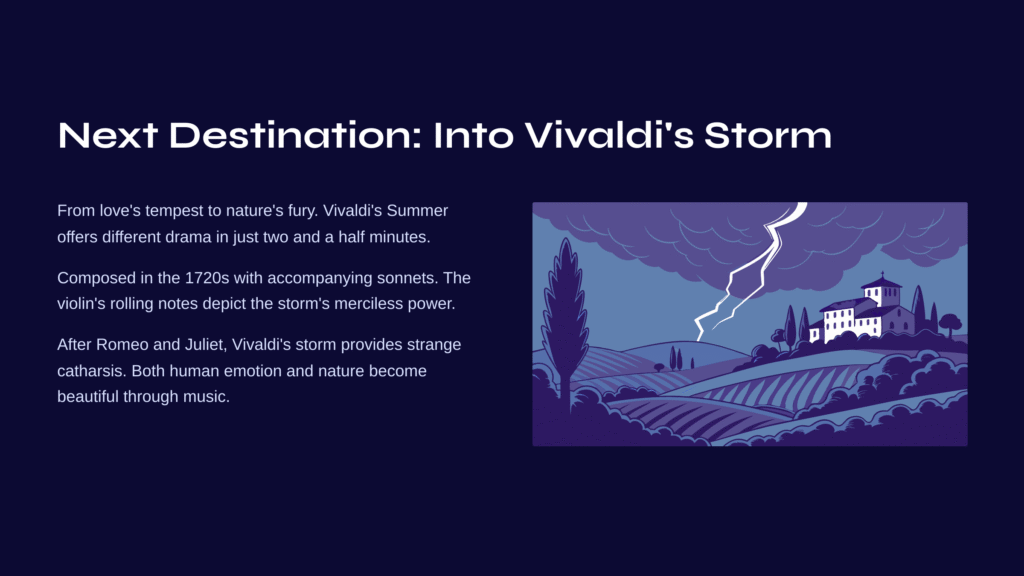
Next Destination: Into Vivaldi’s Storm
From Tchaikovsky’s tale of fateful love, why not turn our gaze to nature’s primal forces? The Presto from Vivaldi’s Summer (third movement of The Four Seasons) offers a completely different kind of drama. If Romeo and Juliet represents the tempest created by human emotion, Vivaldi’s summer storm embodies nature’s own fury and beauty.
Composed in the 1720s, this work stands as an early masterpiece of program music, published alongside sonnets likely written by Vivaldi himself. The third movement’s sonnet warns: “Alas, his fears were justified / The Heavens thunder and roar and with hail / Cut the head off the wheat and damages the grain.”
Where Tchaikovsky painted inner passion with a grand orchestra, Vivaldi vividly recreates nature’s merciless power in just two and a half minutes. The violin’s endlessly rolling notes represent the storm, descending melodies depict hail and lightning, and ascending phrases suggest fierce winds. Listening to this music, you feel as if you’re directly experiencing the shepherd’s helplessness before a sudden summer tempest.
Hearing Vivaldi’s storm after Romeo and Juliet’s tragic love provides a strange catharsis. We realize that while both human emotion and natural forces can overwhelm us, music transforms all of it into beauty.
